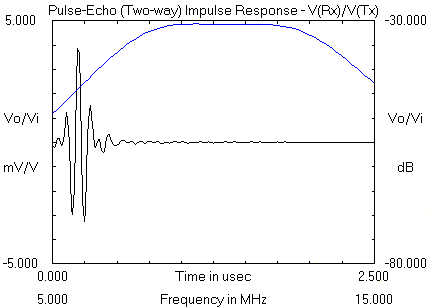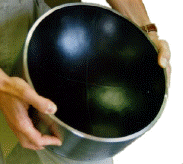| High electroacoustic
performances

|
- Frequency range from 200 kHz to 20 MHz
- High sensitivity and signal to noise
ratio while keeping a high bandwidth
- Precise beam generation with
mechanical or electronical focusing
- High lateral and axial resolution
left : 15 MHz transducer RF echo
|
| Wide range of
Acoustical configurations

Wide aperture focused transducer
|
- Proprietary Piezocomposite technology
with various properties
- Single element, Dual element or
Multielement transducer
- Infinite design possibilities for
multielement active pattern definition
- Cylindrical, spherical, bifocal or
aspherical mechanical focusing (concave or convex)
- Active aperture from 1 mm to 300 mm
depending on the frequency

Miniaturized 17 MHz transducer
|
| Adaptation to
inspection setup |
- Wide range of connector to fit all the
UT electronical devices on the market
- Custom housing to fit the probe holder
or the mechanical environment
|
| Adaptation to
environmental constraints

|
- High and Low temperature
- High pressure
- Nuclear radiation exposure
- Aggressive chemical agents
- Chocks and vibrations
- Normative constraints
left : Miniaturized transducer
used in manned spaceflight
|
| Adaptation to
coupling method |
- Immersion with water, oil or other
fluids
- Contact with hard or soft materials
- Local immersion
- Air coupling
|
| Adaptation to the
pieces to be inspected |
- High attenuation blocks or large depth
inspections
- Complex geometry pieces with space
constraints
|
| Adaptation to
inspection techniques |
- Pulse echo
- Pitch/Catch
- Transmission
- Time Of Flight Diffraction
- Advanced techniques, etc ..
|



